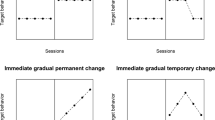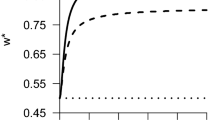Abstract
An up and down (U&D) procedure is a sequential experiment used in binary response trials for identifying the treatment corresponding to a prespecified probability of positive response. Recently, a group version of U&D procedures has been proposed whereby at each stage a group of units is treated at the same level and the number of observed positive responses determines the treatment assigned to the next group. The deterministic nature of this algorithm leads to some limitations that in this paper we propose to overcome by introducing a randomization mechanism. A broad class of randomized group U&D’s is presented, giving the conditions for targeting the treatment level of interest. In addition, we study how the properties of the design change as we vary the method of randomization within this general class and find randomization schemes which guarantee desirable results in terms of the asymptotic behavior of the experiment.
Similar content being viewed by others
References
Baldi Antognini A. (2005). On the speed of convergence of some urn designs for the balanced allocation of two treatments. Metrika 62: 309–322
Bortot P., Giovagnoli A. (2005). Up and down experiments of first and second order. Journal of Statistical Planning and Inference 134: 236–253
Derman C. (1957). Non-parametric up-and-down experimentation. Annals of Mathematical Statistics. 28: 795–799
Dixon W.J, Mood A.M. (1948). A method for obtaining and analyzing sensitivity data. Journal of the American Statistical Association 43: 109–126
Durham S.D., Flournoy N. (1994). Random walks for quantile estimation. Statistical Decision Theory and Related Topics V: 467–476
Durham, S.D., Flournoy, N. (1995). Up and down design: stationary treatment distributions. Adaptive designs. In: Flournoy, N., Rosenberger, W.F. (eds.) IMS Lecture Notes, col 25, Hayward, pp. 139–157.
Durham S.D., Flournoy N., Rosenberger W.F. (1997). A random walk rule for phase I clinical trials. Biometrics 53: 745–760
Gezmu M., Flournoy N. (2006). Group up-and-down designs for dose-finding. Journal of Statistical Planning and Inference 136: 1749–1764
Giovagnoli A., Pintacuda N. (1998). Properties of frequency distributions induced by general ‘up-and-down’ methods for estimating quantiles. Journal of Statistical Planning and Inference 74: 51–63
Giovagnoli A. (2004). Markovian properties of some biased coin designs. In: Di Bucchianico A., Läuter H., Wynn H.P. (eds) mODa 7-Advances in Model-Oriented Design Analysis, Contributions to Statistics. Physica-Verlag, Heidelberg, pp 69–76
Ivanova A., Montazer-Haghighi A., Mohanti S.G., Durham S.D. (2003). Improved up-and-down designs for phase I trials. Statistics in Medicine 22: 69–82
Korn E.L., Midthune D., Chen T.T., Rubinstein L.V., Christian M.C., Simon R.M. (1994). A comparison of two phase I trial designs. Statistics in Medicine 13: 1799–1806
Mugno R., Zhus W., Rosenberger W.F. (2004). Adaptive urn designs for estimating several percentages of a dose-response curve. Statistics in Medicine, 23: 2137–2150
O’Quigley J. (2002). Curve-free and model-based continual reassessment method designs. Biometrics 58: 245–249
Piantadosi S. (1997). Clinical trials: a methodologic perspective. New York, Wiley
Rosenberger W.F. (2002). Randomized urn models and sequential design. Sequential Analysis 21: 1–28
Rosenberger W.F., Lachin J.M. (2002). Randomization in clinical trials. New York, Wiley
Ross S. (1996). Stochastic processes. New York, Wiley
Storer B.E. (1998). Phase I trials. In: Armitage P., Colton T. (eds) Encyclopedia of Biostatistics. New York, Wiley, pp. 3365–3370
Stylianou M., Flournoy N. (2002). Dose finding using the biased coin up-and-down design and isotonic regression. Biometrics 58: 171–177
Tsutakawa R.K. (1967). Random walk design in bio-assay. Journal of the American Statistical Association 62: 842–856
Author information
Authors and Affiliations
Corresponding author
About this article
Cite this article
Antognini, A.B., Bortot, P. & Giovagnoli, A. Randomized group up and down experiments. AISM 60, 45–59 (2008). https://doi.org/10.1007/s10463-006-0081-5
Received:
Revised:
Published:
Issue Date:
DOI: https://doi.org/10.1007/s10463-006-0081-5




